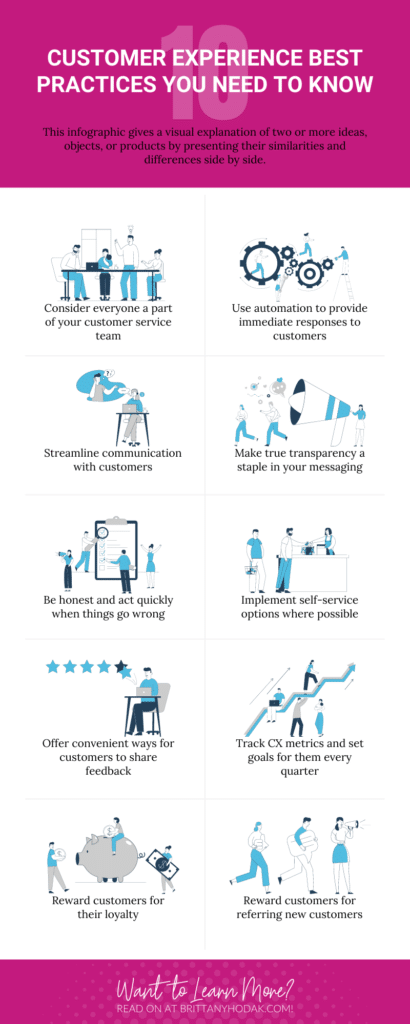In today’s world, few things matter more to your brand than the customer experience. More than just a trendy buzzword, your customer experience is the foundation for your entire business. If you follow the customer experience best practices, you not only boost your revenue. You also promote loyalty, retain engaged customers, and create raving superfans.
In the past, brands did what’s called an “inside out” approach. This means basing decisions on what was best for the business, not their customers. Today, the tables have turned. Winning companies adopt an outside-in approach, meaning they’re affected by the needs and expectations of customers.
Positive experiences don’t just result in more brand awareness. In fact, 74% of customers are at least somewhat likely to buy based on experience alone. That means a positive experience has the potential for long-term payoff. As we enter what’s called the “feedback economy,” your customers’ opinions are more public than ever before. The entire economy is built on reputation, feedback, reviews, and social shares.
It’s time to make your customers a top priority. These 10 customer experience best practices are what you need to know to succeed this year and beyond. The better you understand your audience, the better equipped you are to create an experience designed for them.
- Consider everyone a part of your customer service team.
- Use automation to provide immediate responses to customers.
- Streamline communication between customers and your team.
- Make true transparency a staple in your messaging.
- Be honest and act quickly when things go wrong.
- Implement self-service options where possible.
- Offer convenient ways for customers to share feedback.
- Track CX metrics and set goals for them every quarter.
- Reward customers for their loyalty.
- Reward customers for recommending your products/services.
- Check-in with Your Customer Experience
Consider everyone a part of your customer service team.
One of the first customer experience best practices that you need to know is about inclusivity. When it comes to customer service, you can’t keep your team in silos. While most brands focus their customer service training on the service team, this is a mistake. Every branch of the company interacts with customers in some way, from sales to IT.
When you consider everyone in your company as a part of your customer service team, everyone is prepared to make every interaction a good one. No matter how small, your customer experience is the sum of every interaction—no matter how small. A reported 63% of customers say the best brands exceed expectations at every stage of the customer journey. This is something you need to build into every team, training, and interaction.
How do you include everyone at your brand in your service team? It starts by demonstrating and modeling these values as a team. This means defining a culture of positivity, helpfulness, and compassion. From there, give your whole team the training, experience, and tools they need to build better experiences.
Use automation to provide immediate responses to customers.
Second, time is of the essence when it comes to the customer experience. We can all relate to the frustration of having to wait several hours or even days for a response. Not only is this annoying, but it has the potential to push you towards a competitor. Instead, use automation to provide immediate responses to customers.
Thanks to modern technology, people have shorter patience than ever before. We want what we want fast. A startling 31% of customers want a response from brands within an hour or less. The sooner you can get to customers, the better. Because it’s impractical to have a team member waiting night and day to answer concerns, let new technology shine through.
Automation can handle most customer concerns today with ease. Using an AI tool to manage basic customer concerns or follow up with customers lets them know their time matters to you. For example, Expedia has a “Virtual Agent” bot that helps with canceling bookings, refund status, and so on in just a few clicks.
Streamline communication between customers and your team.
Third, brands need to streamline communication between customers and teams. There is often a disconnect between customer feedback and your team. Except for your support staff, most teams aren’t aware of how consumers feel about changes, updates, and so on. This feedback is essential as part of the customer experience best practices.
It’s your job to break down these walls in communication. This all comes down to the accessibility of information. When teams stay transparent about changes from the top-down, everyone feels in the loop. Your team members are advocates for your success—make sure they feel included.
From there, make it as easy as possible for your customers to reach your team. This means including multiple methods of communication, like email, phone, or chat. Consider the ways your audience likes to communicate. There is no one-size-fits-all. When in doubt, ask them yourself! We don’t all have the same communication styles, and you want to personalize the experience to your customers’ needs.
Make true transparency a staple in your messaging.
Next, your brand needs to be an advocate for transparency. In the feedback economy, transparency has never been more influential. While it’s easy to throw around the term “transparency” without any action to back it up, customers see through this quickly. You just have to look at industry giants like Facebook to see how quickly a company’s trust spirals downward by failing to invest in transparency.
Even though Facebook claims to be committed to transparency moving forward, the damage is done. People no longer trust Facebook with their data, and it’s an upward battle to change this narrative. Brand transparency is when a company proves itself to be open, accessible, and genuine. Brand transparency means being clear with your messaging, owning up to problems quickly, and never playing the blame game.
One of the biggest examples of brand transparency is the skincare brand Lush. With clearly displayed policies and values on the company website, Lush is committed to ethical buying and ethos. All of Lush’s ingredients are listed, even going as far as to define what “safe synthetics” means. By committing to these levels of authenticity, Lush earns trust.
Be honest and act quickly when things go wrong.
Speaking of transparency, another customer experience best practice you need to know has to do with when things go wrong. Accidents happen, and things fall through the cracks. It can be intimidating to clean up your hypothetical mess, but how you act in times of crisis makes all the difference.
When things go wrong (and they will), you need to be honest. Don’t play the blame game and point fingers. When you turn a situation around, you prove that you care about the customer experience. There are a lot of ways to solve the problem:
- Share what went wrong and how you’ll prevent it in the future
- Own up to mistakes quickly and publicly
- Offer a discount, free product, or incentive to win back trust
- Create an action plan for problems in the future
If you fail to prepare, you’re preparing to fail. When things go wrong, brands show their true colors. You want to make sure your light shines through even on the darkest of days. This is what separates the weak links from the strong players.
Implement self-service options where possible.
With that in mind, now is also the time to make sure your users can help themselves. Customers are savvier than ever before. They want self-service options so they can get answers themselves. A reported 79% of customers today expect organizations to have self-service support tools. Tools like frequently asked questions and guides eliminate the need for additional support.
However, the key is to make sure you’re adding high-value self-service. With most customers trying to solve issues on their own before contacting support, you want them to be as successful as possible on their first try. Still, 77% of people say poor self-service is worse than no self-service at all.
One online platform that understands the power of self-service support is AncestryDNA. They understand that genealogy can be confusing, especially when it comes to DNA tools. Their knowledge base, FAQs, and guides help users answer their questions quickly. This is even true for complex questions, like building your family tree.
Offer convenient ways for customers to share feedback.
Next, are you making it easy for customers to share feedback? Your customers want to be heard more than ever before. As we mentioned above, we’ve officially entered the feedback economy. That means feedback is becoming its own form of currency.
Don’t just assume you know what your customers are thinking. With over 50% of people believing companies need to take action on feedback from customers, you need to create a feedback plan. The good news is many of your most engaged customers are already ready to give feedback, but you need to create opportunities for sharing:
- Surveys: Surveys are the easiest way to get feedback, and they’re also easy to analyze. Boxes: A structured way to get feedback after specific interactions is through feedback boxes on your own website. These commonly show up after a purchase, support interaction, or blog post.
- Directly: Though undervalued, you can also reach out to customers directly. If you have the time, talking to customers directly gives you insight into their thoughts.
The easier it is for customers to share feedback, the better. They likely won’t go out of their way to complete a survey, for example. You need to build it into your customer journey, taking inventory of your progress along the way.
Track CX metrics and set goals for them every quarter.
Additionally, your customer experience metrics also are a valuable way to understand your customers’ needs. There are a lot of key customer metrics to monitor, and these can paint a broad picture of your strengths and weaknesses.
One of the most powerful ways to monitor your CX is the Net Promoter Score (NPS). This measures whether or not your customers would refer you to someone in your network. Typically done on a scale of 0 to 10, customers are asked how likely they’ll recommend you. Another option is the Customer Satisfaction Score (CSAT). This measures the satisfaction or a specific experience.
For example, the financial management tool Wave uses NPS scores to set clear goals. They send simple emails asking how likely users are to recommend Wave to their friends, getting a clear answer right away.
Reward customers for their loyalty.
One of the last customer experience best practices to know is how to reward customers for their loyalty. Like in real-world relationships, loyalty means everything to brands. Customers choose to be loyal for all kinds of reasons, but the most common has to do with the customer experience.
While it’s easy to focus on acquiring new customers, you might be putting your eggs in the wrong basket. Instead, 82% of customers agree that retention is cheaper than customer acquisition. Not only do existing customers spend more, but they also are your biggest advocates.
However, your customers won’t stick around for the sake of it. You need to consistently reward them for their loyalty, encouraging them to continue supporting you into the future. There are a lot of effective ways to reward customers like rewards programs, discounts, special offerings, and even in-person events. People want to feel like they’re a part of something special, especially when you build a community around your brand.
Reward customers for recommending your products/services.
Last but not least, reward your customers for recommending you. When customers take the time to recommend you, they’re sharing your brand with others. Referrals are worth their weight in gold, and they result in a higher payoff for you long-term. Since people trust those in their inner circles, these referrals carry a lot of weight.
You can offer discounts to existing users, rewards points, or even free products. Referred customers are 4 times more likely to refer others to your brand themselves, so it’s important to consider this throughout the customer journey.
You can see a lot of brands in action when it comes to referral programs. One industry where you see this often is credit cards. For example, Discover offers a statement credit for any customer who refers a new member. Additionally, the referred member gets their own statement credit after they make a purchase in the first 3 months.
Check-in with Your Customer Experience
Ultimately, now is the right time to check in with your current customer experience. There are a lot of factors that go into making a good customer experience, and this is far from one-and-done. It’s an ongoing process that’s essential if you want to succeed in the future.
The good news is you don’t have to reinvent the wheel. These customer experience best practices are the foundation for any brand, big or small. How will you create the next wave of superfans for your business?






